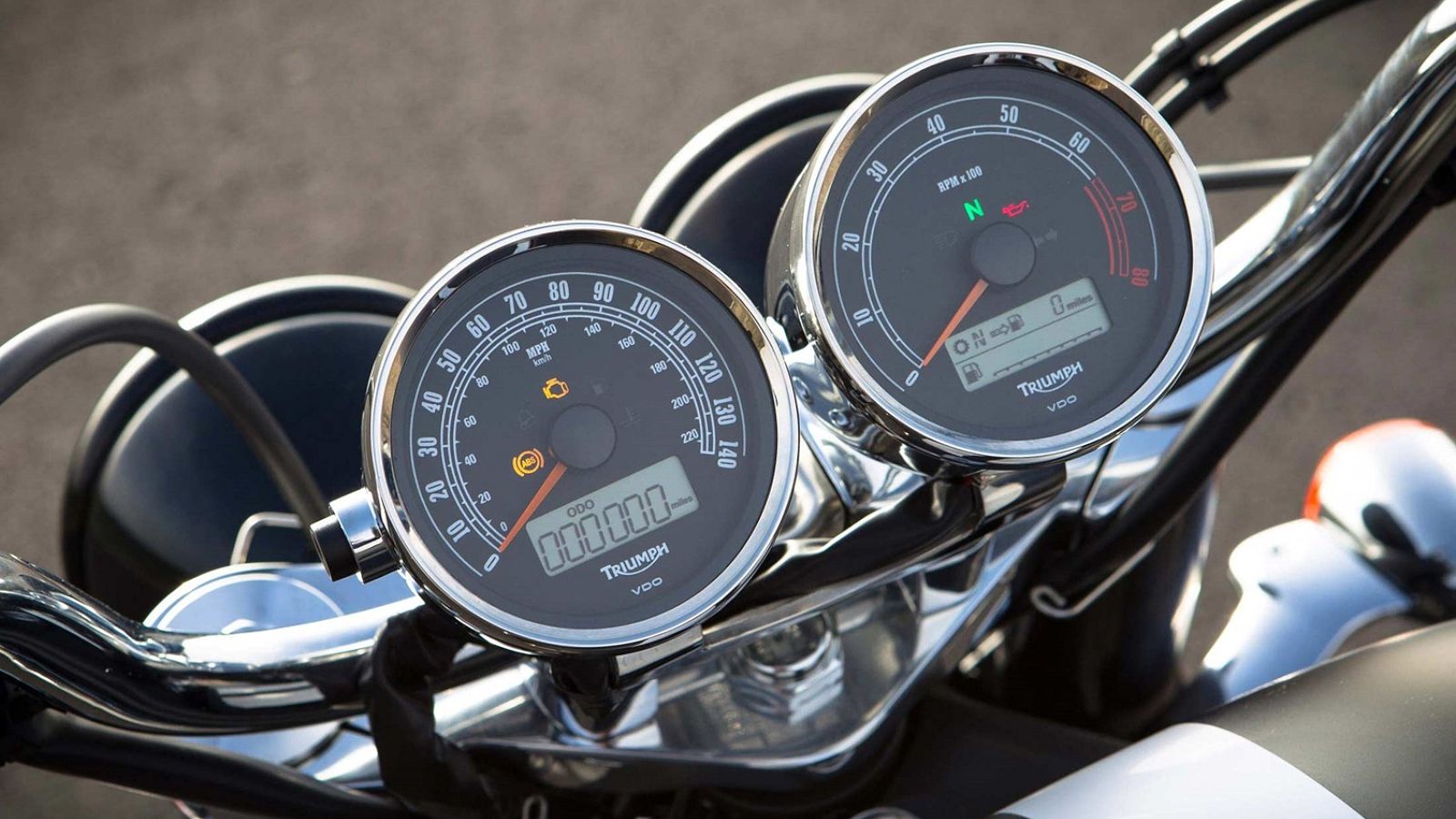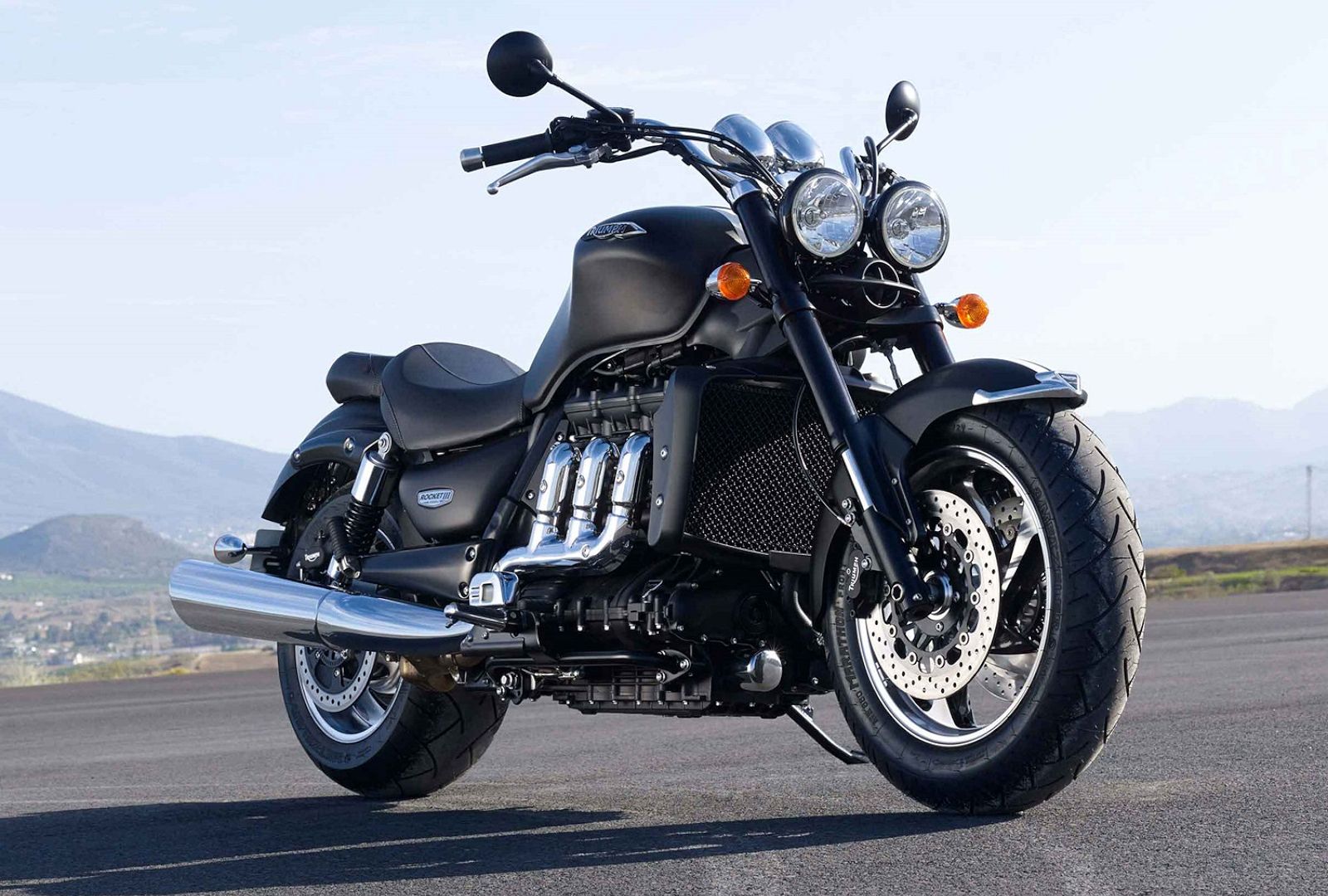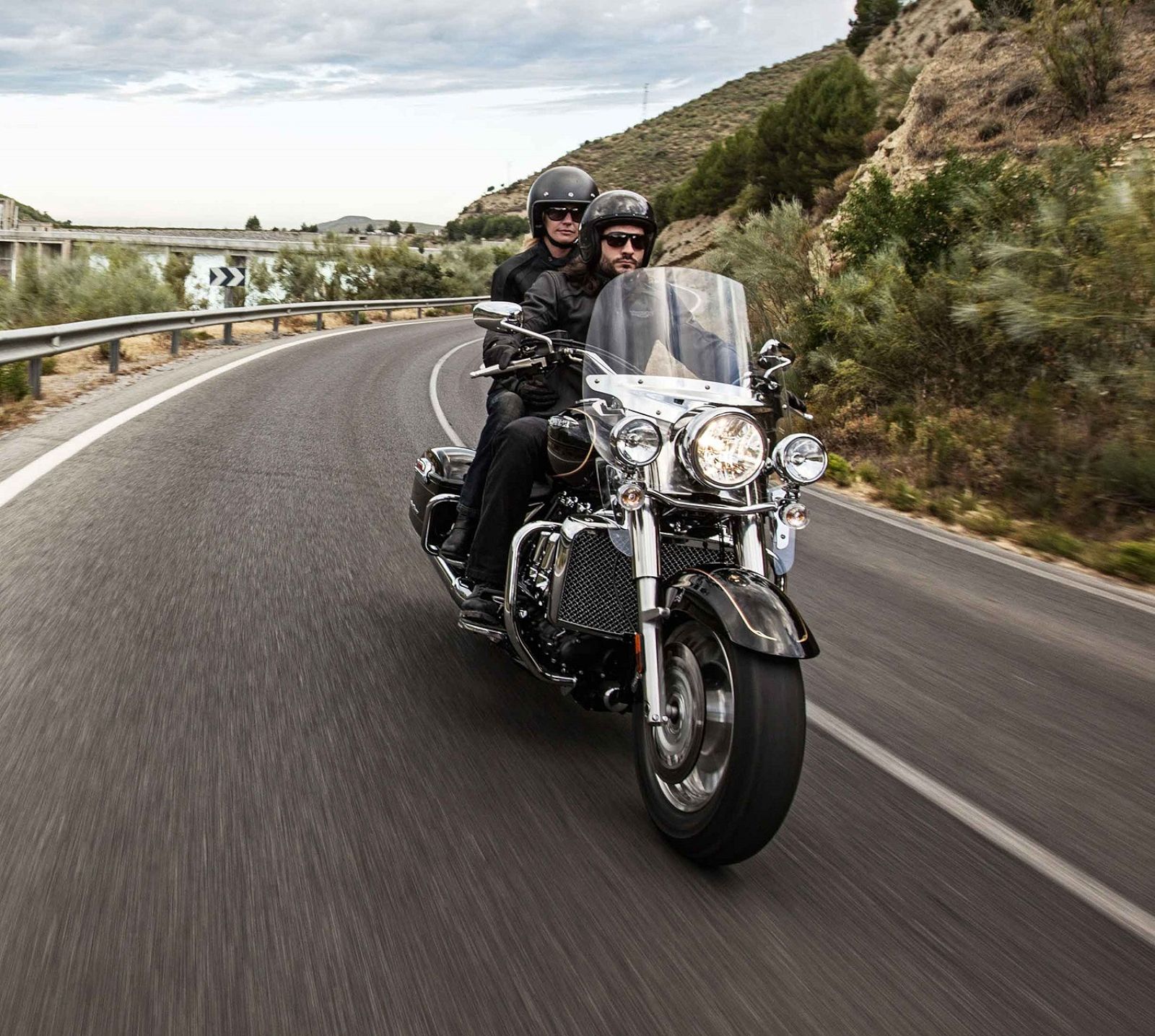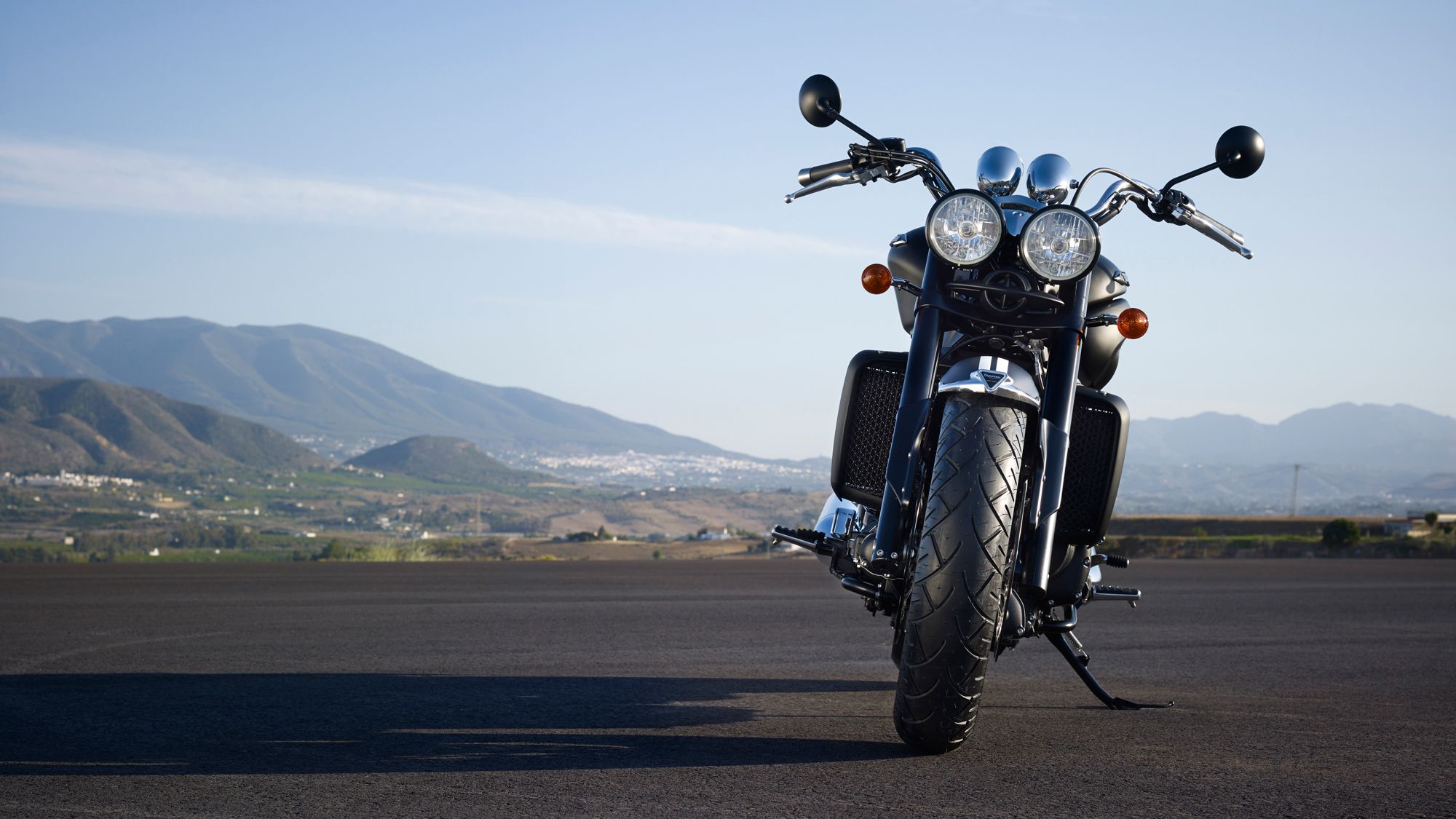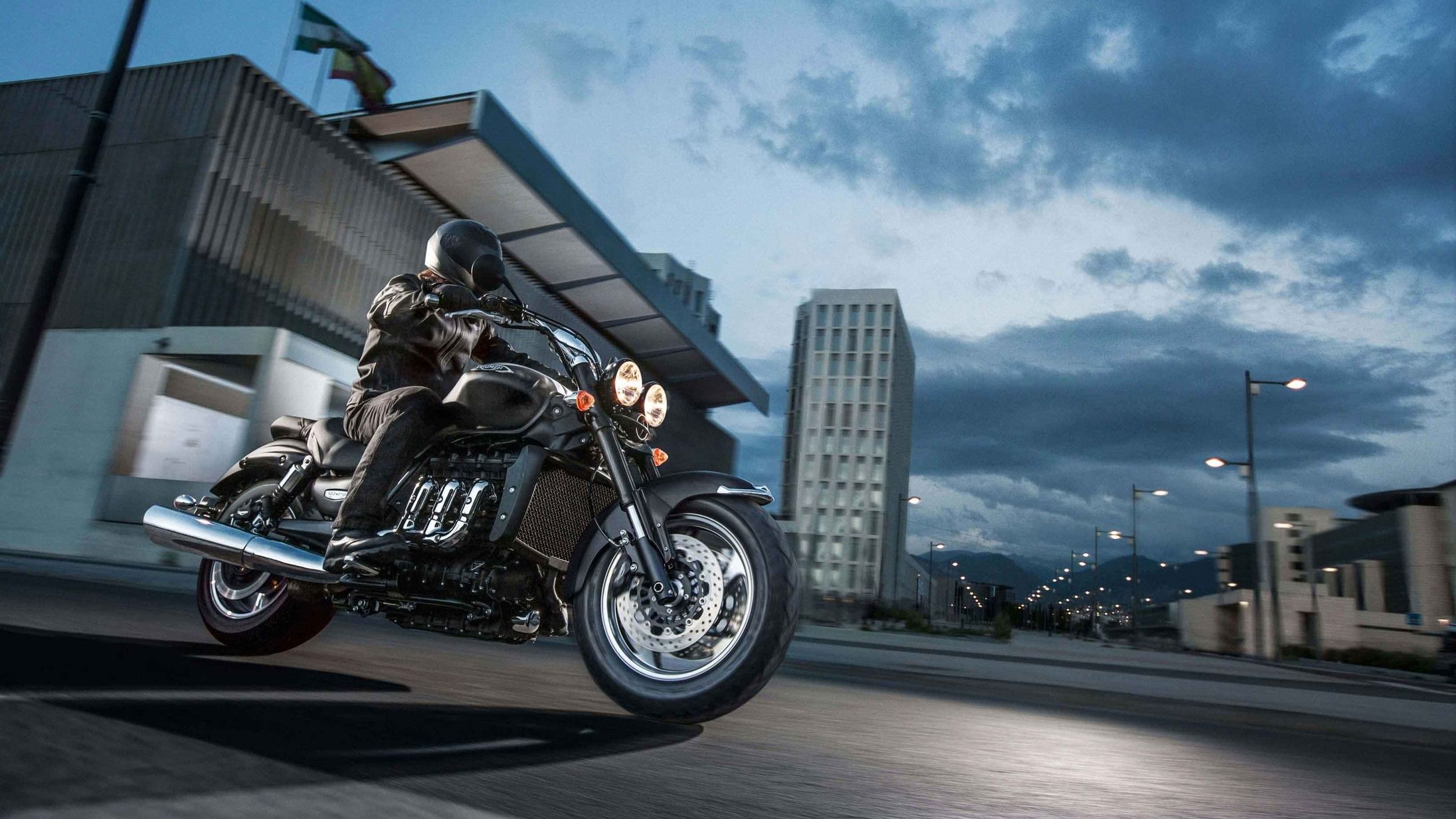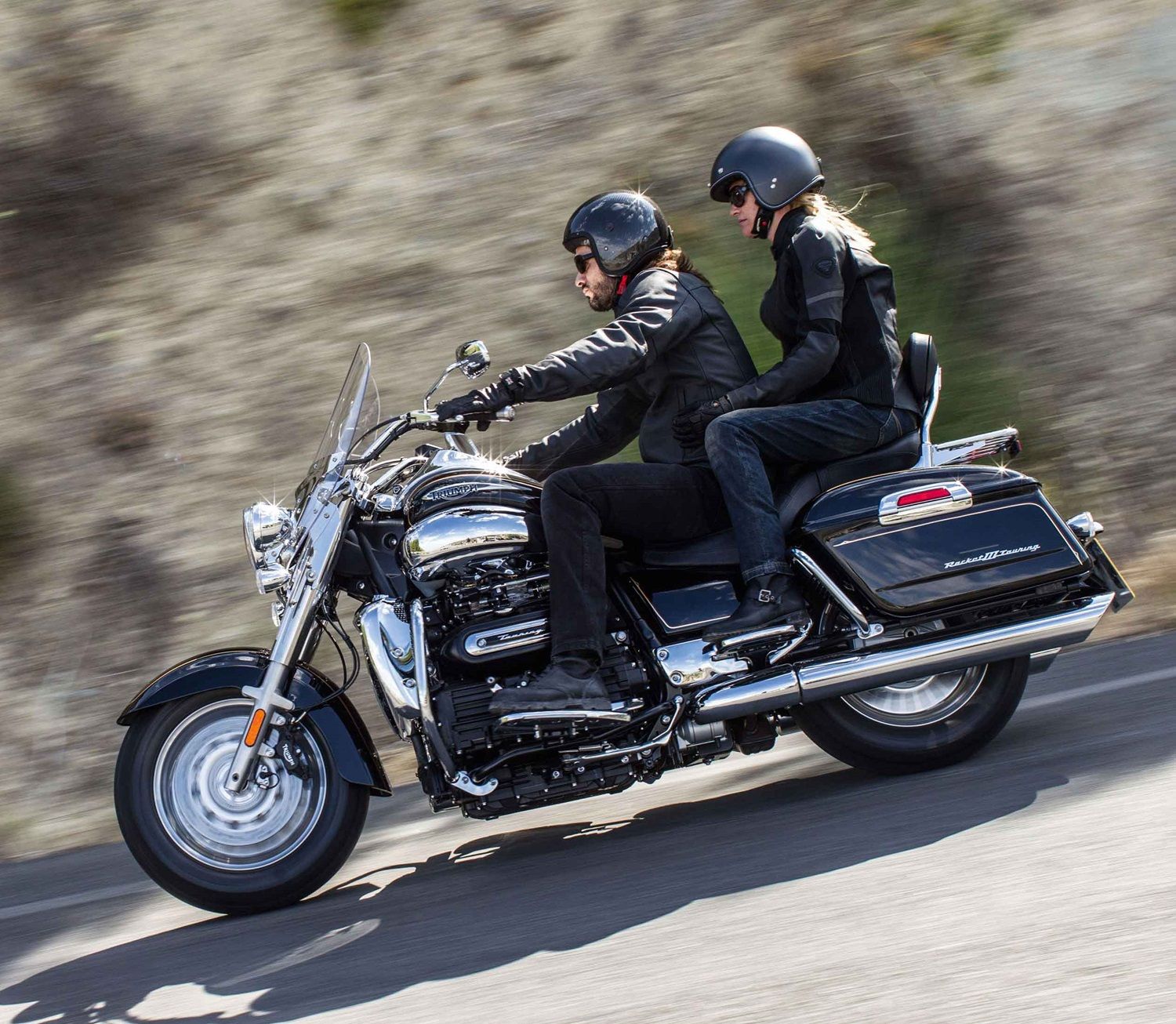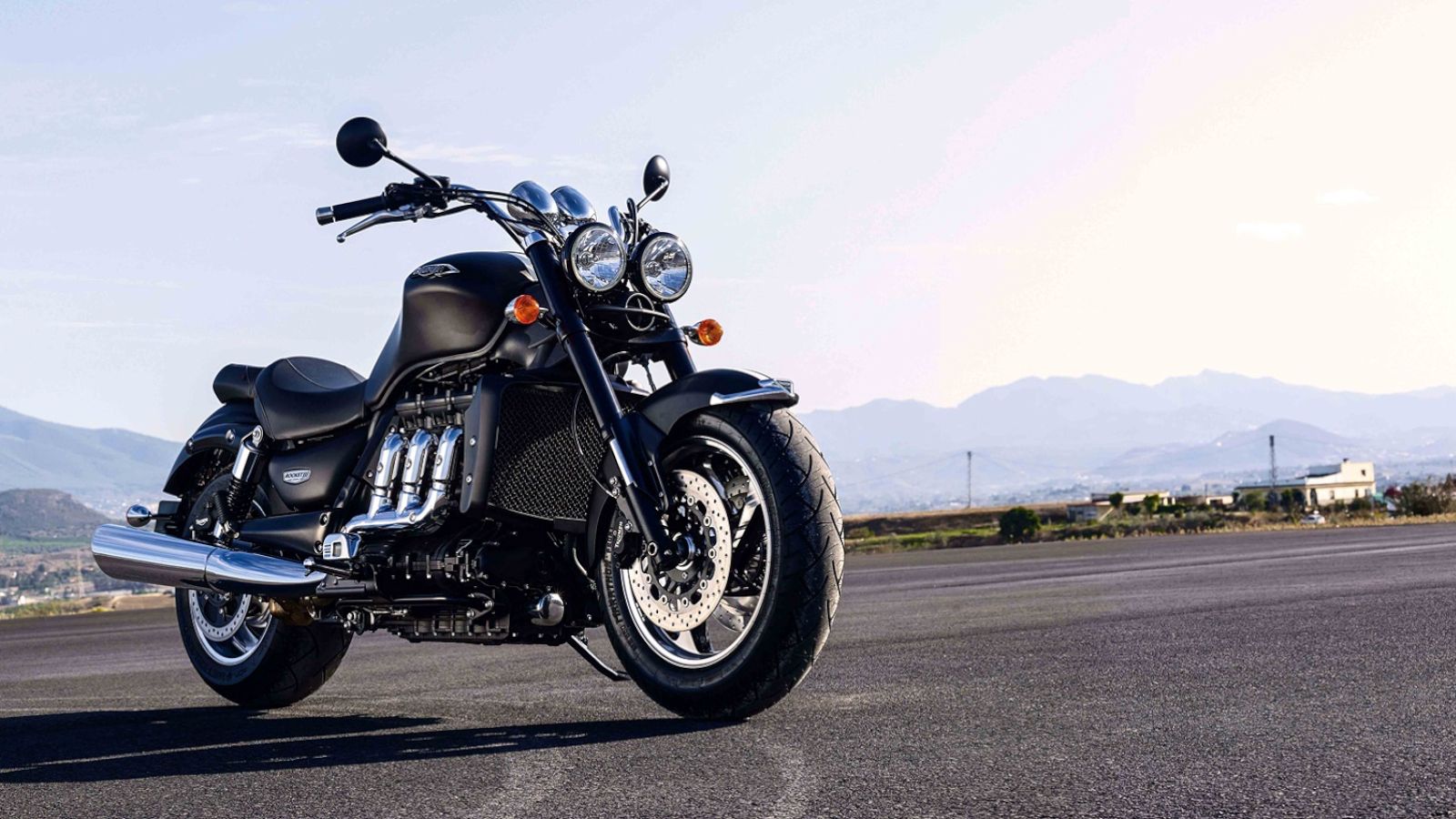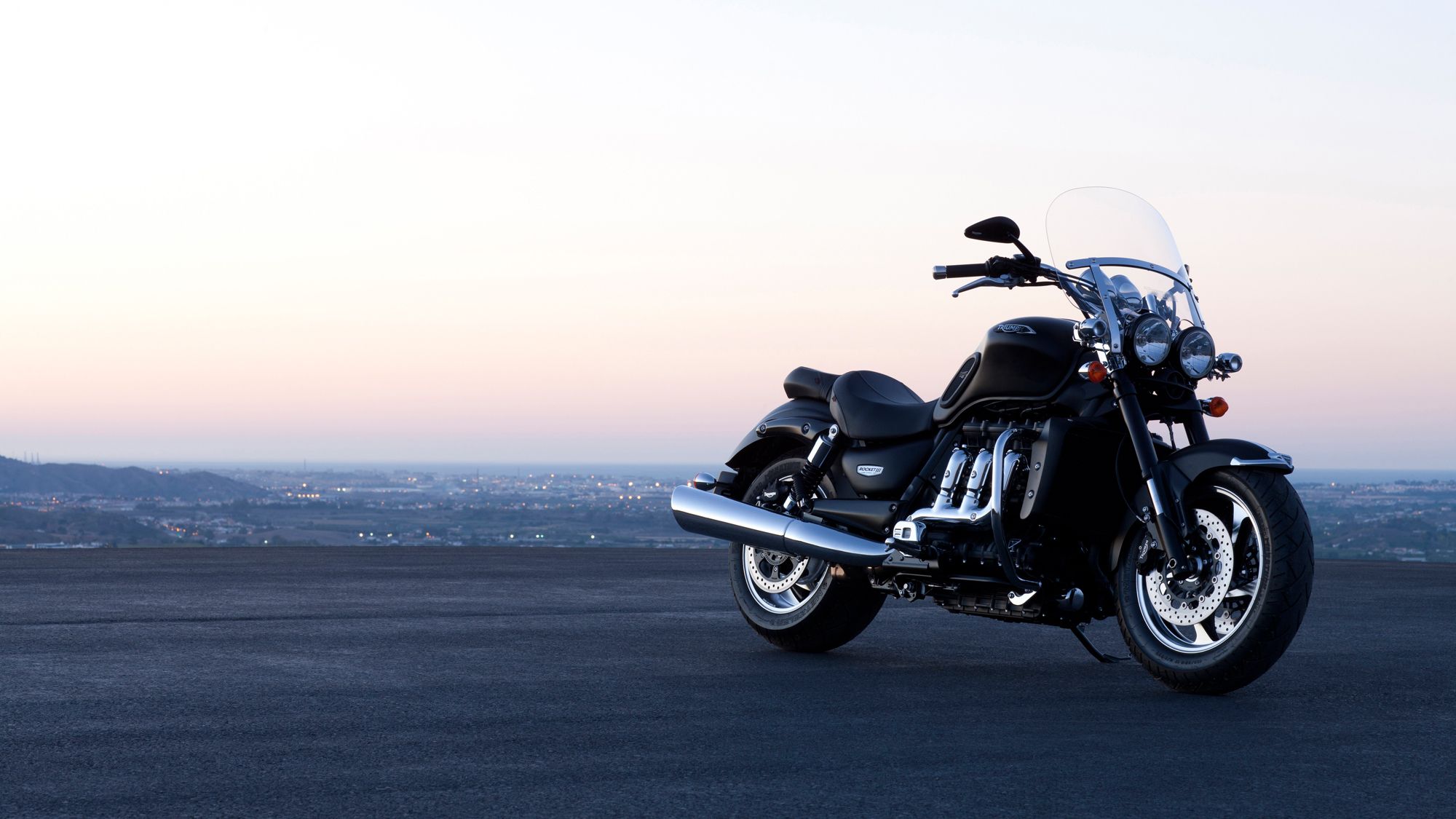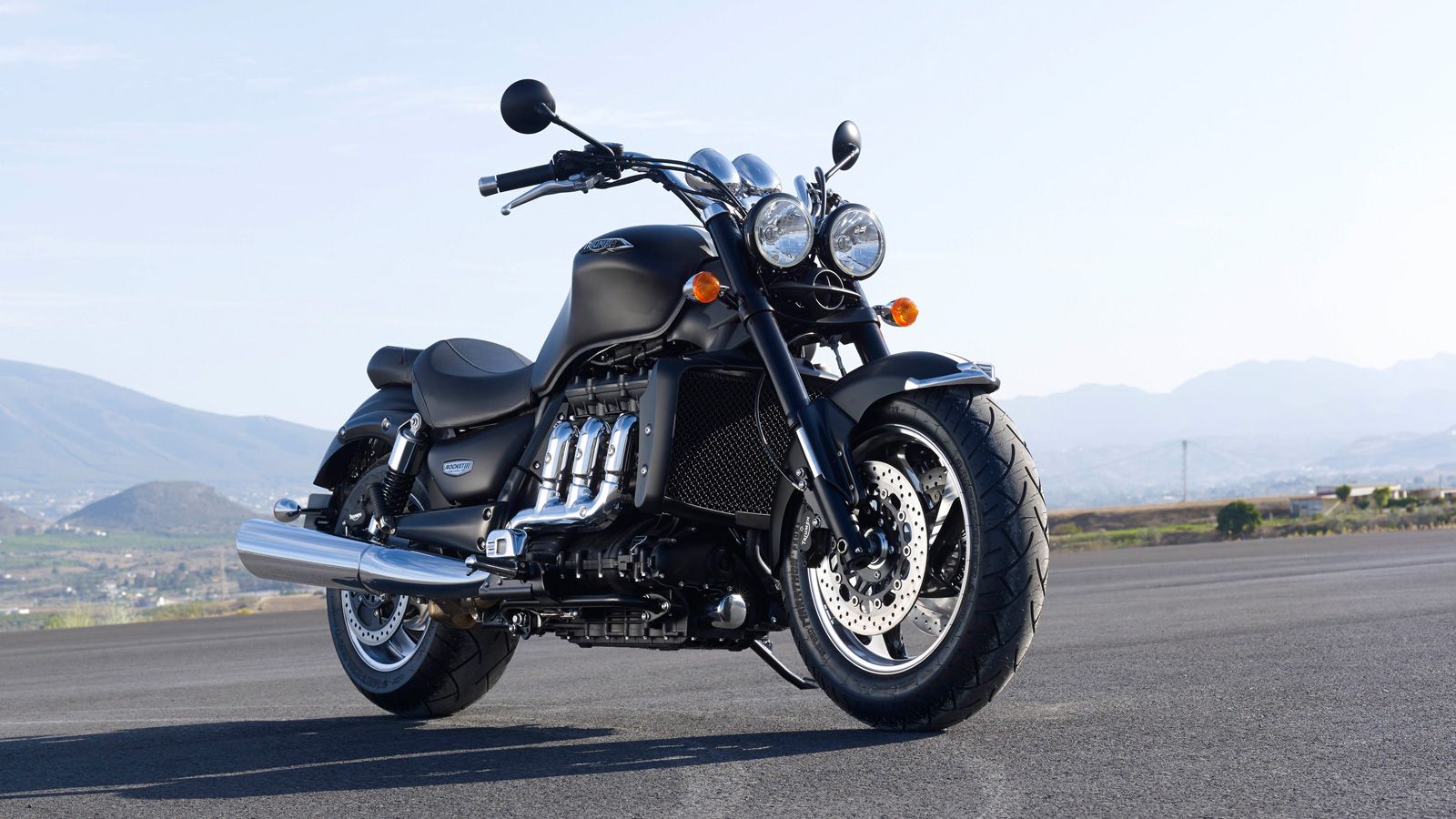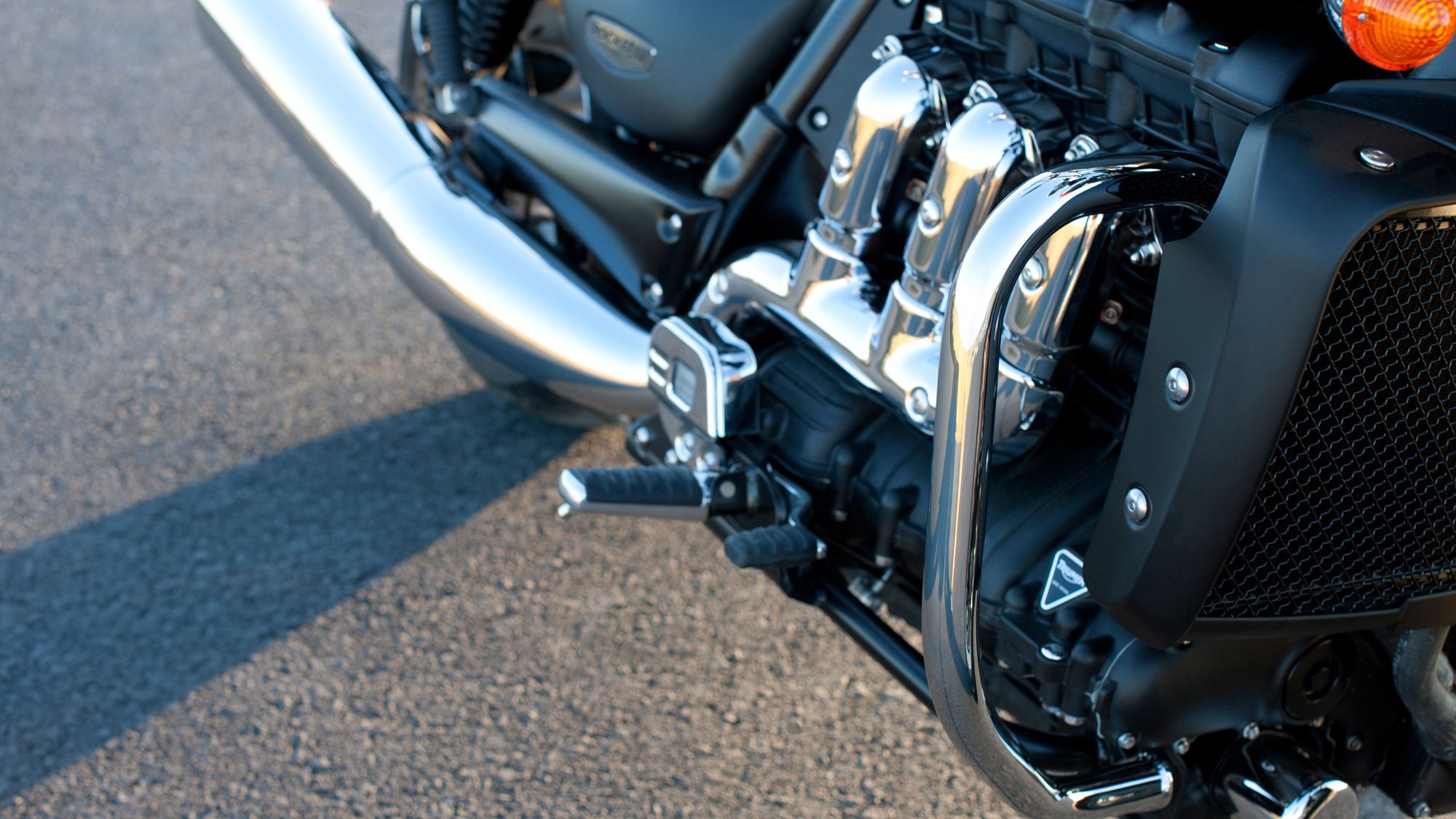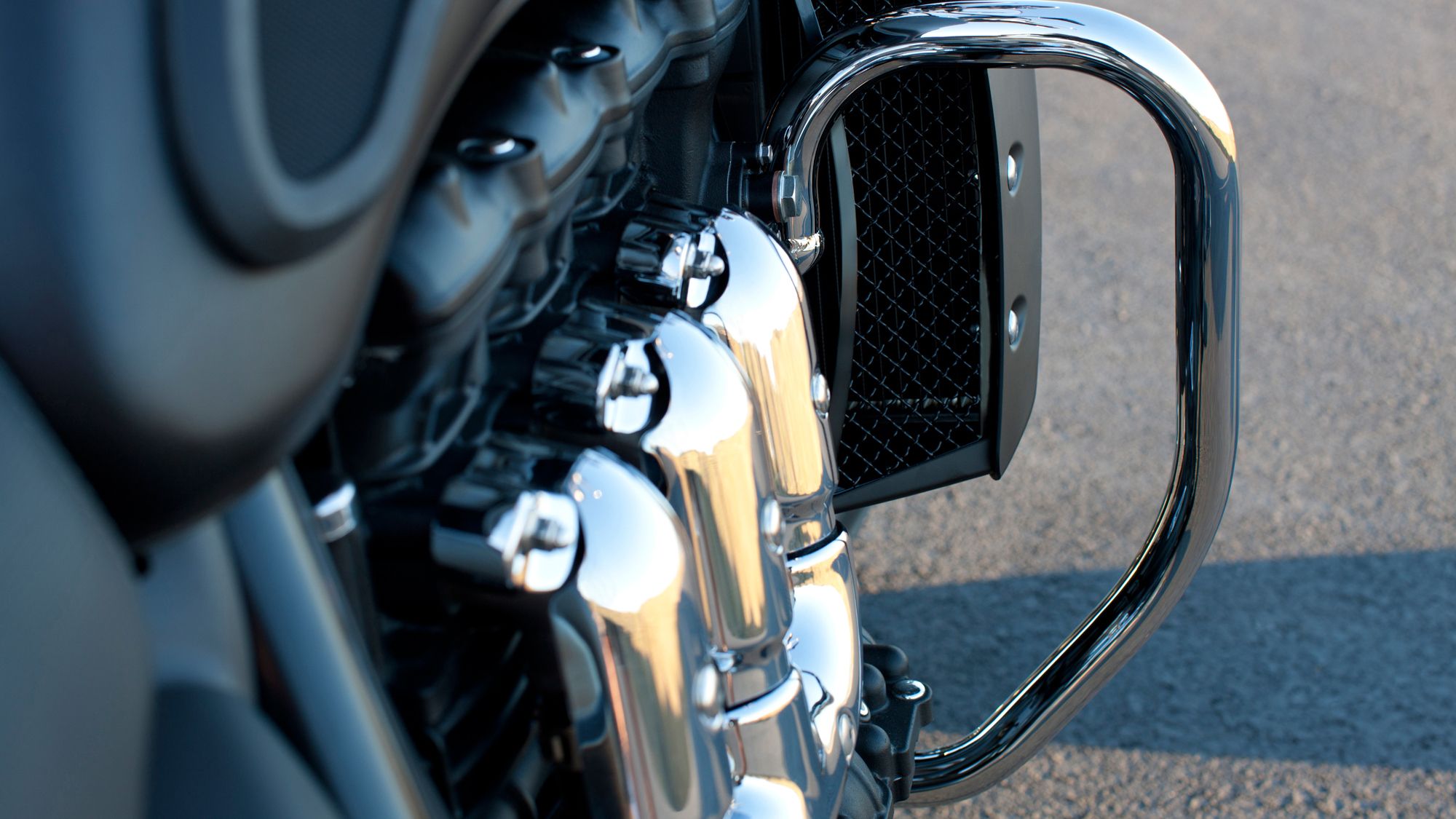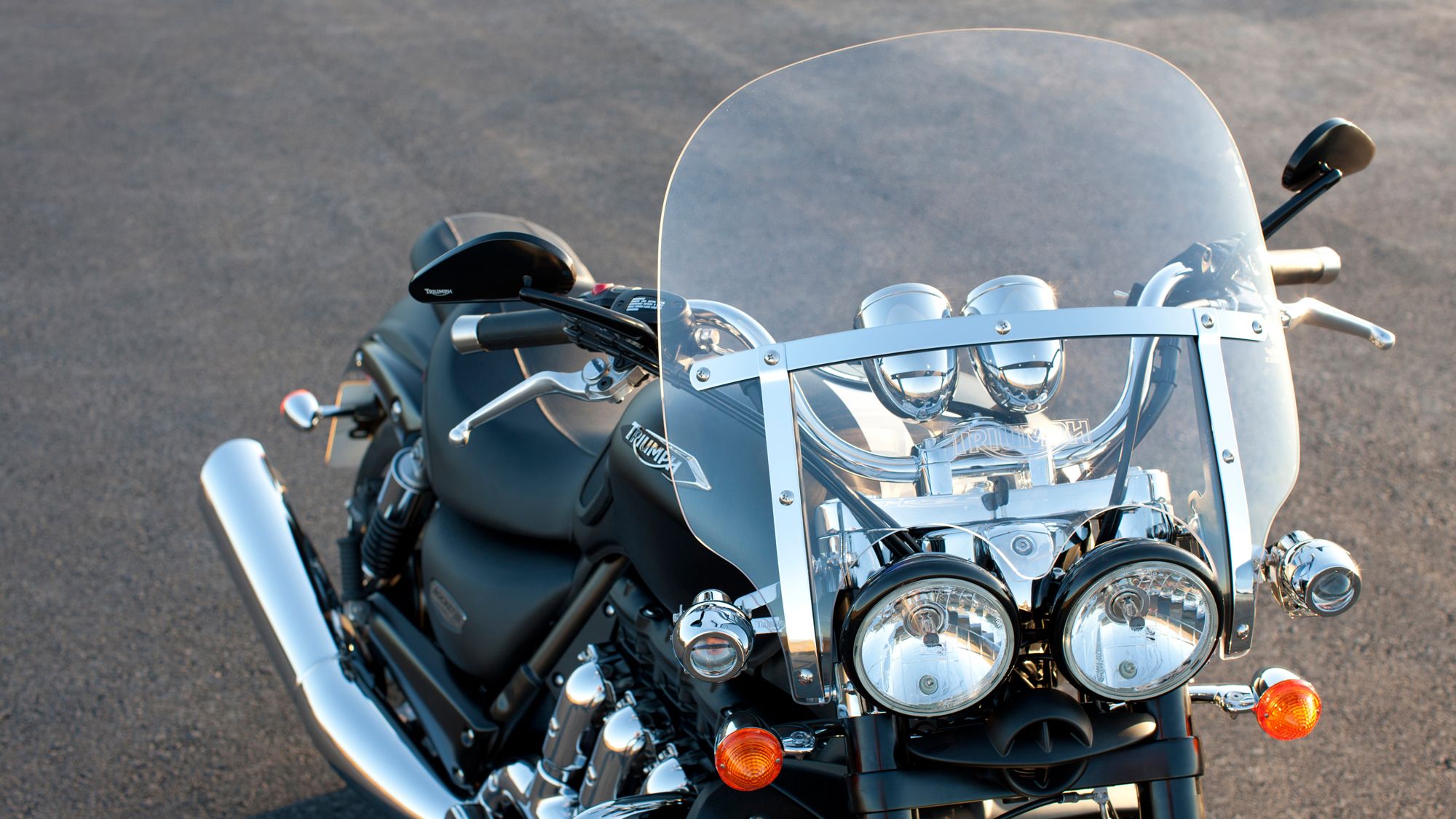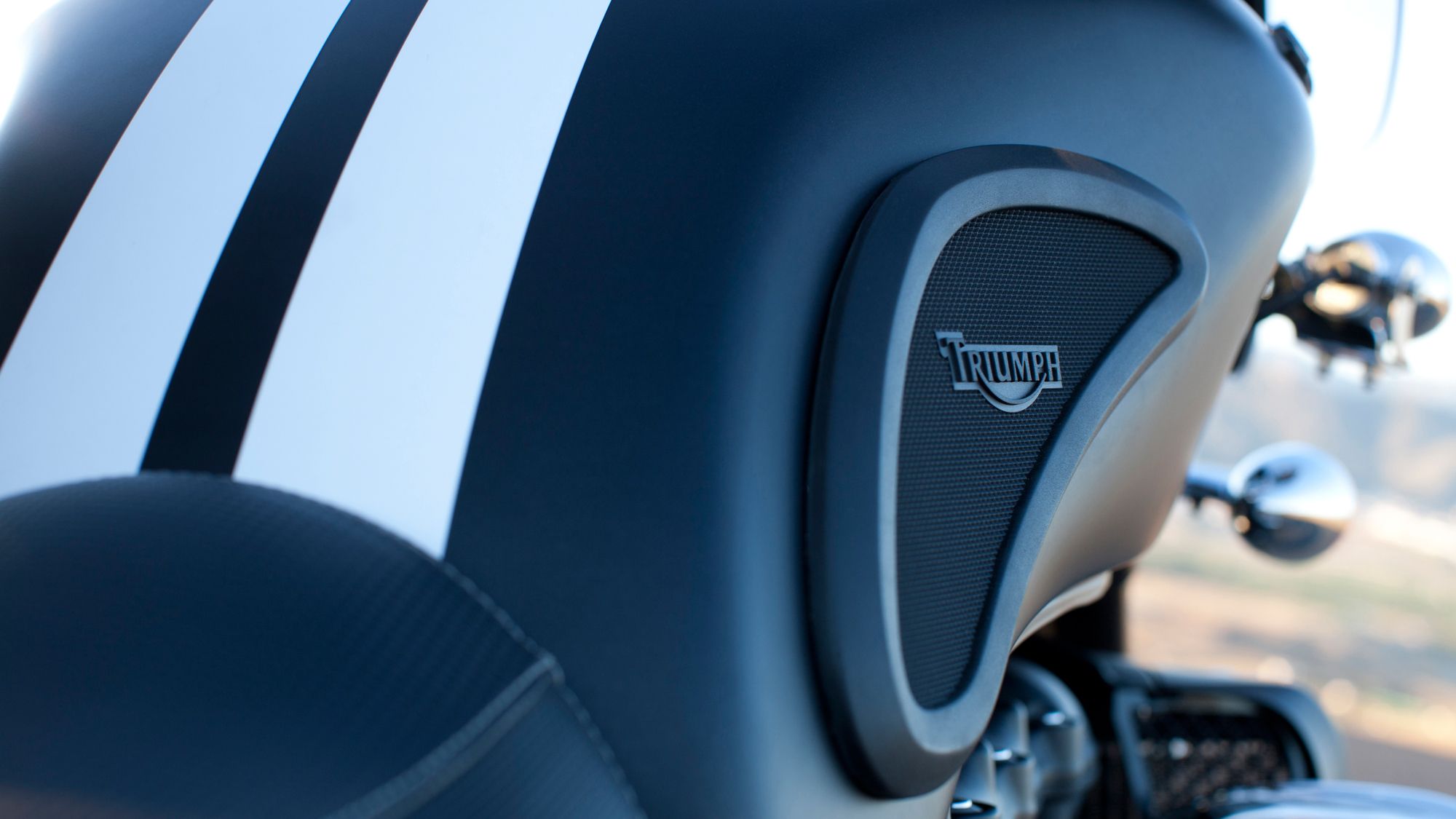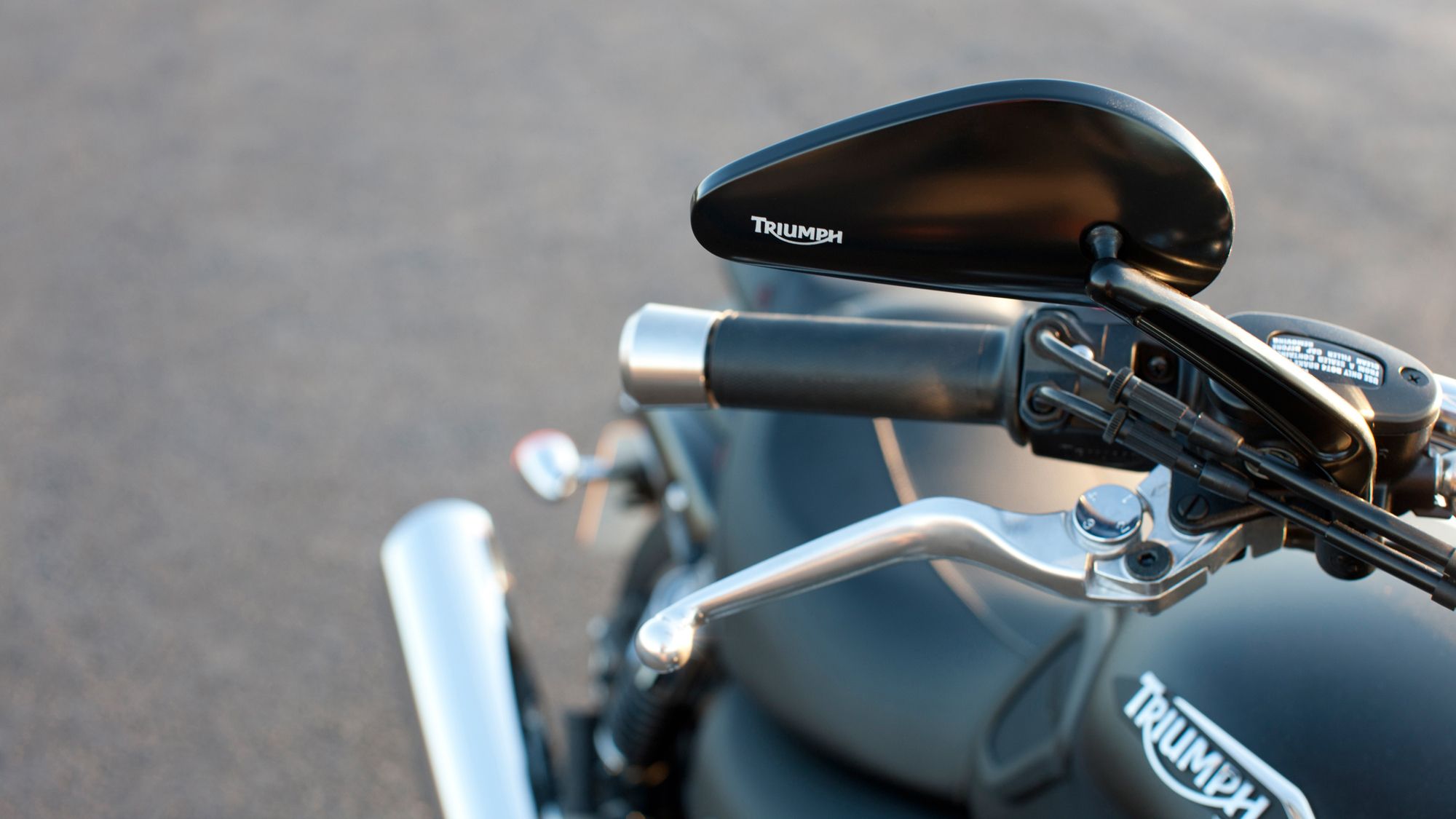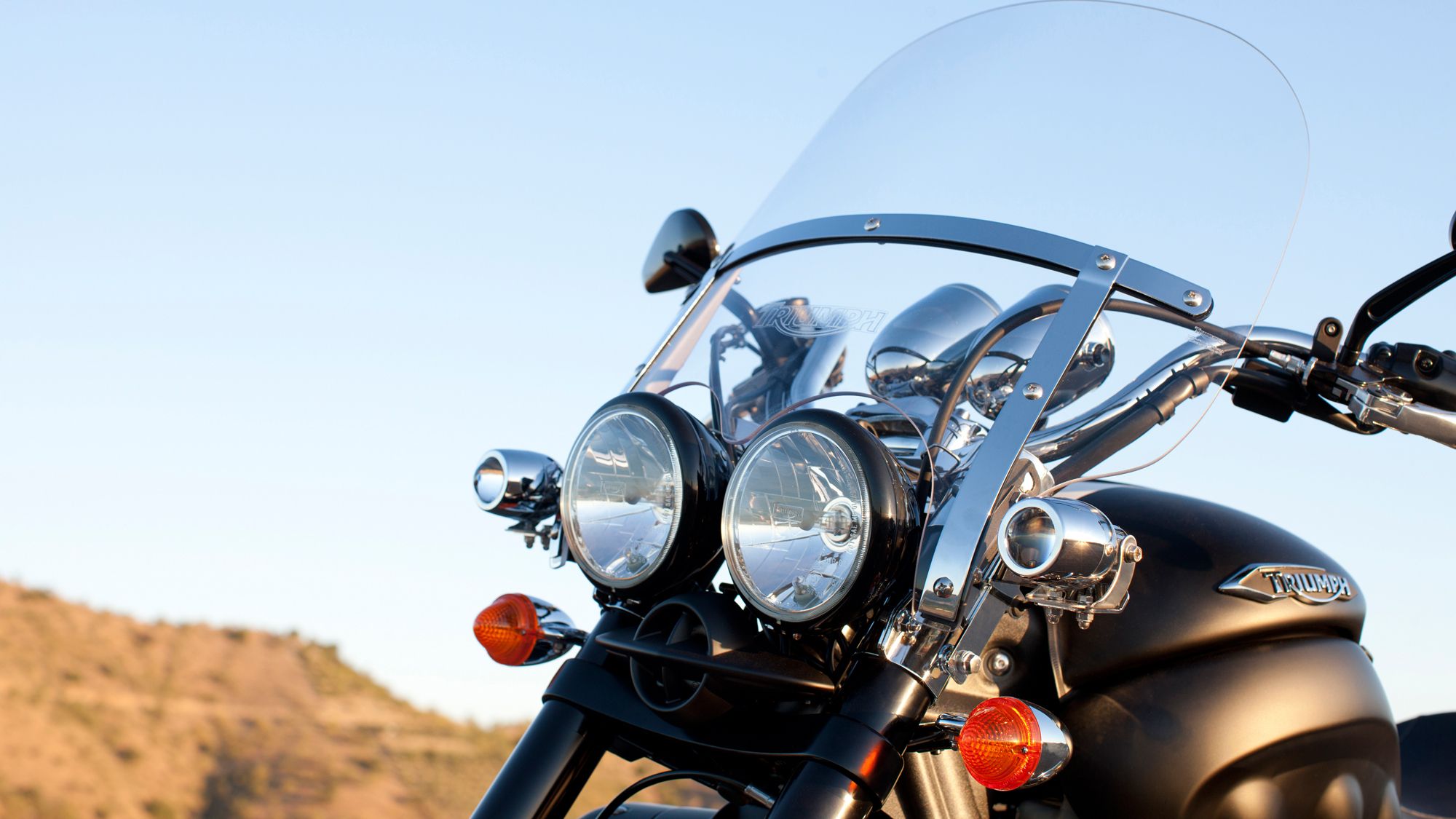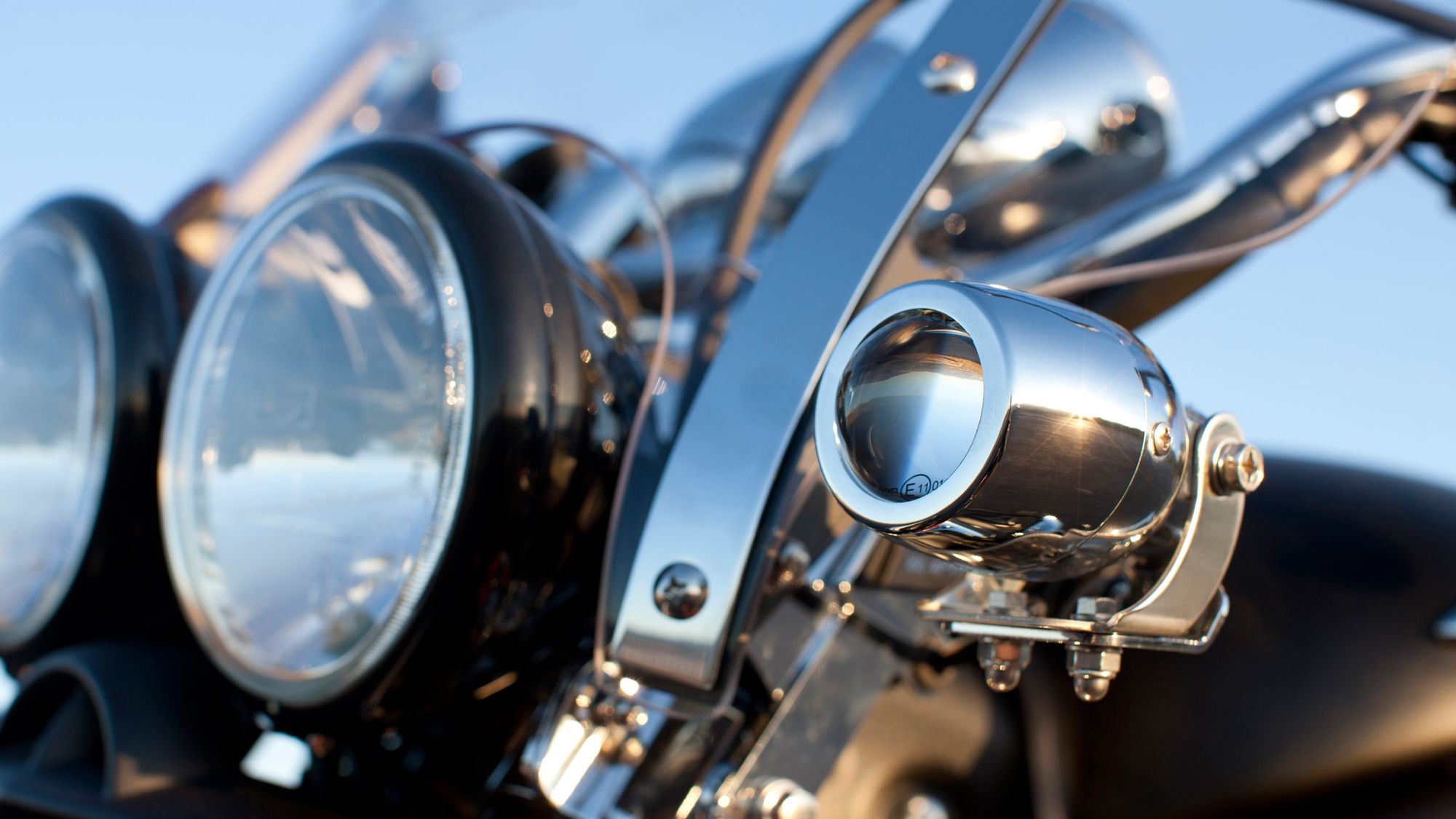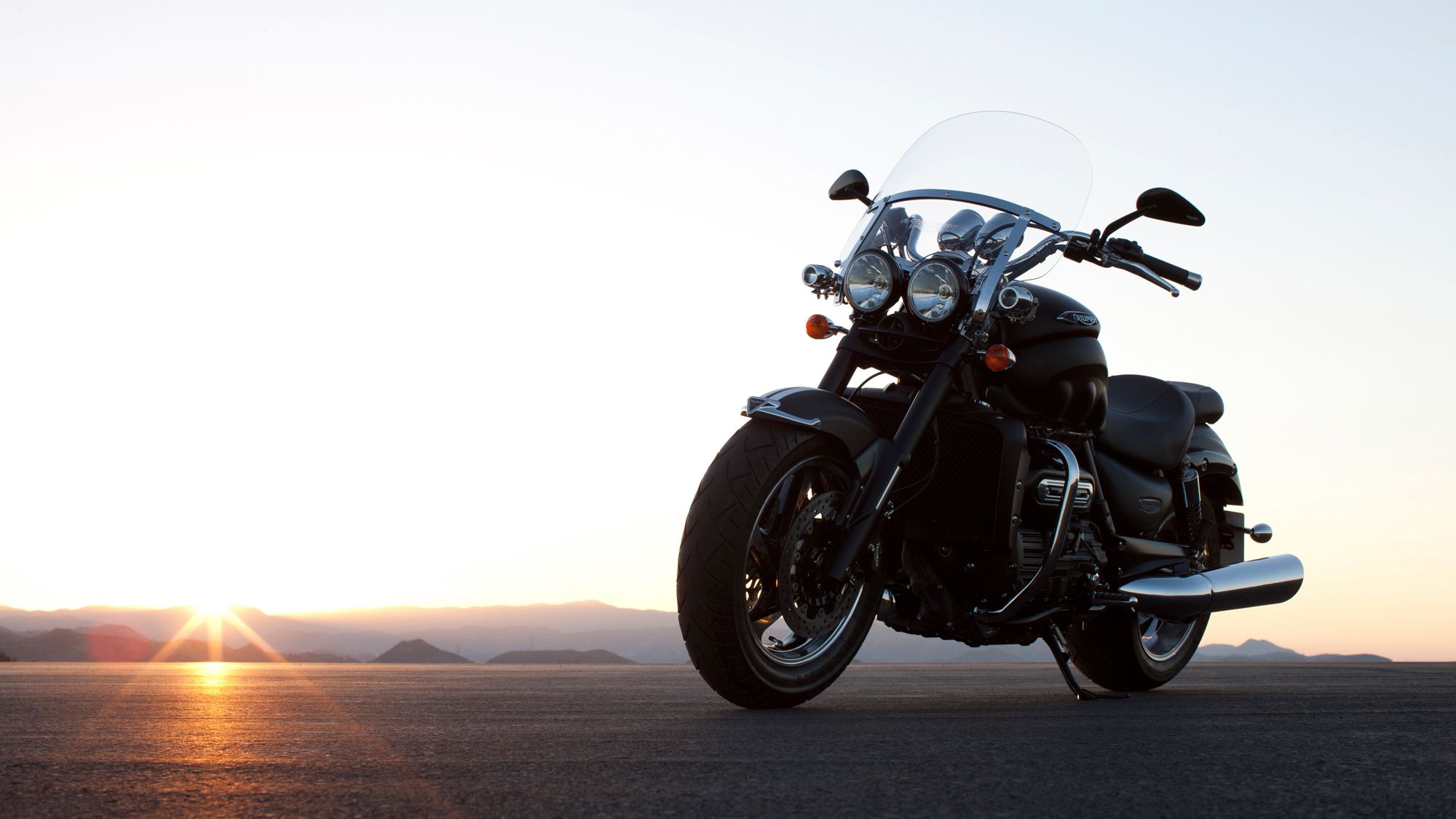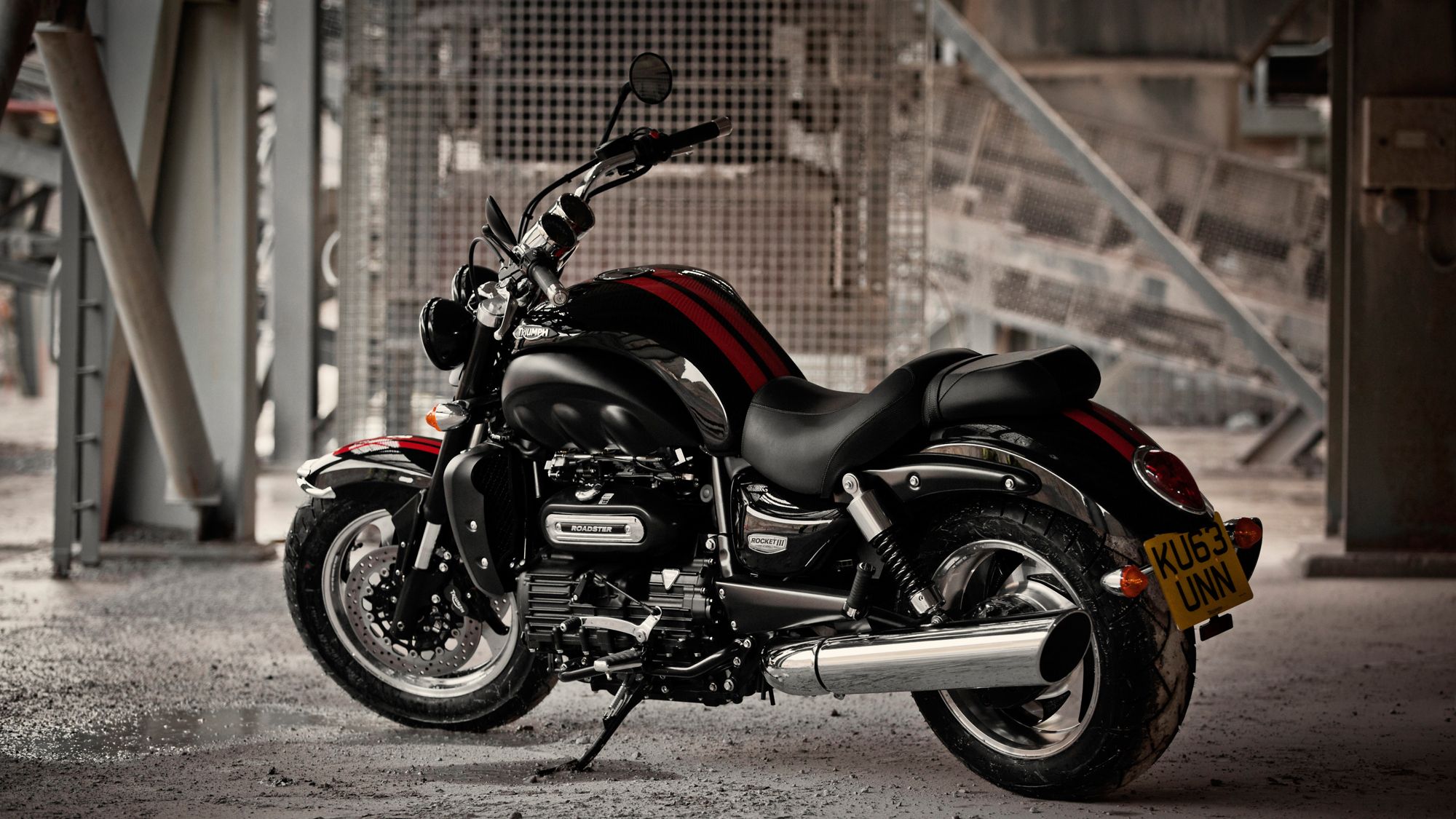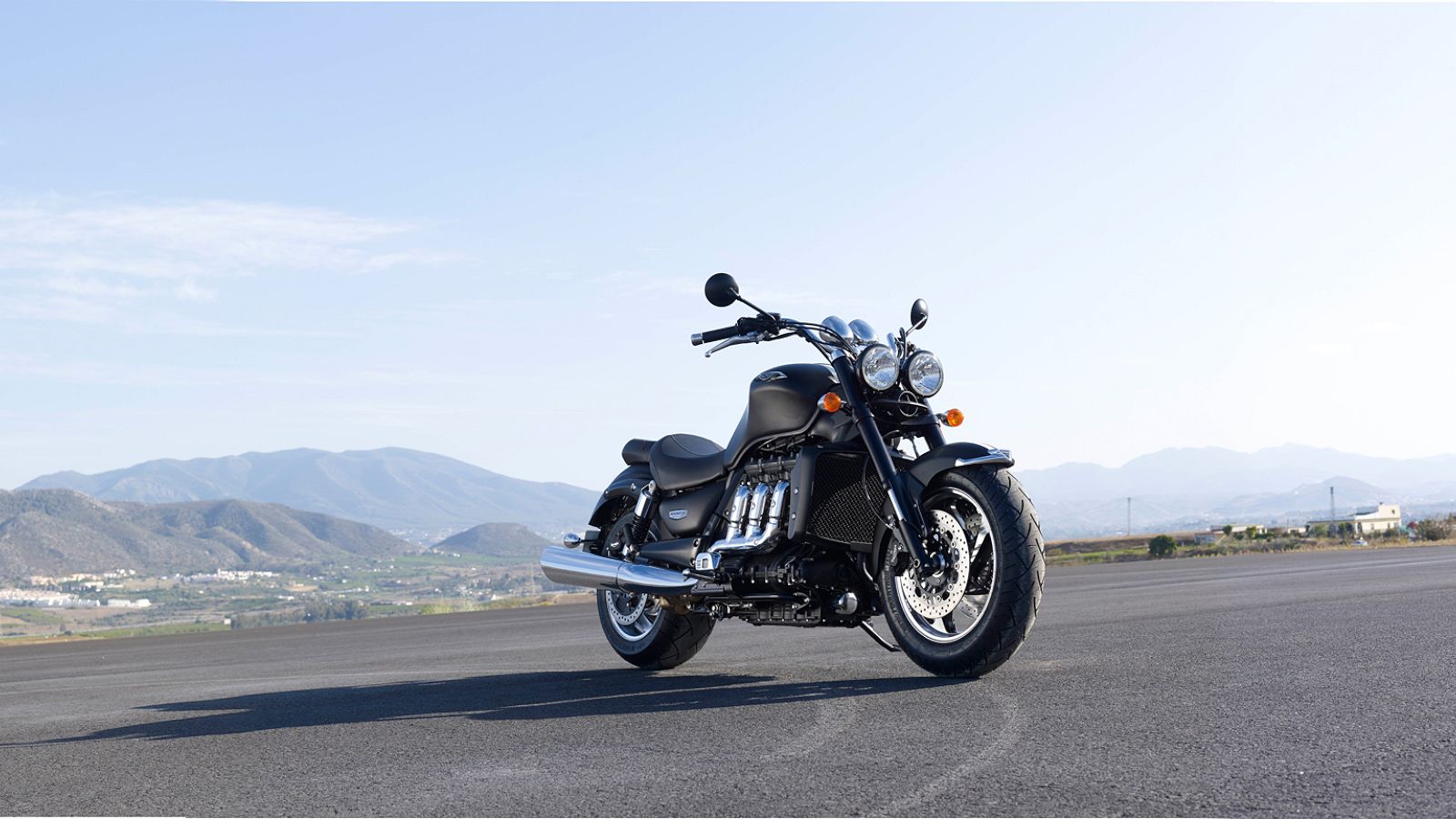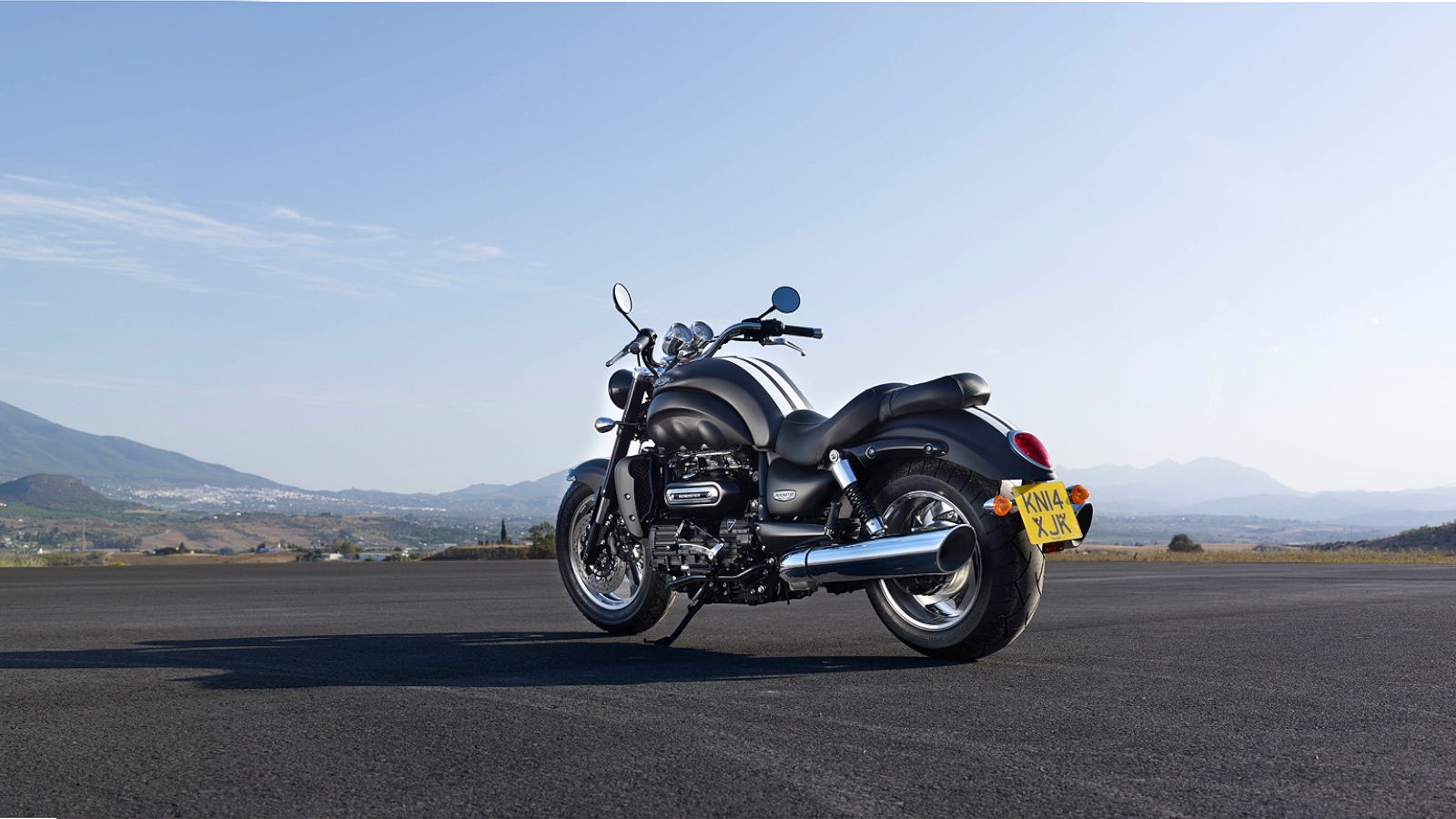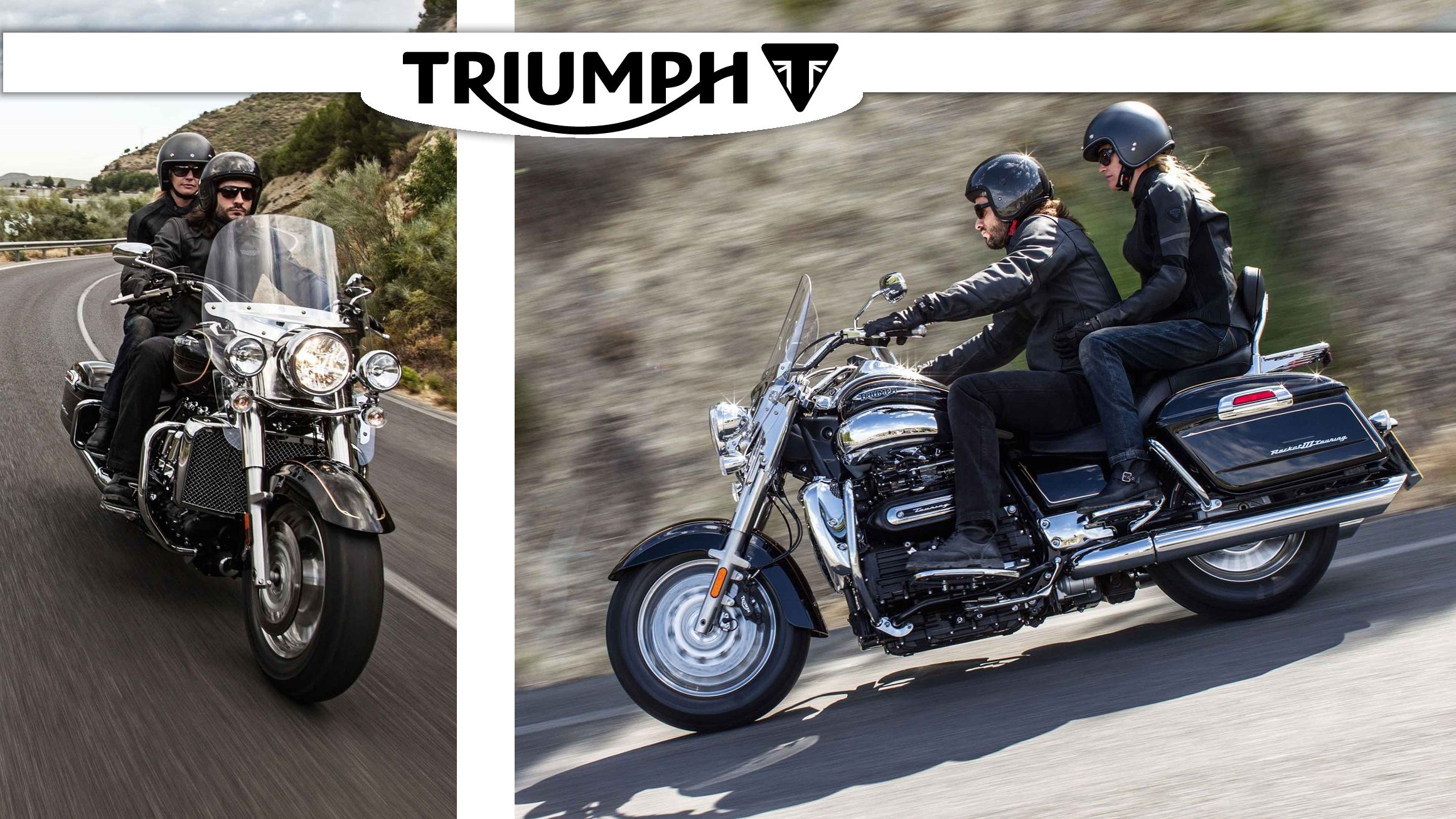Triumph takes a shot at the U.S. power-cruiser market with its Rocket III Roadster. Wrapped in a very cruise-tastic package, the Roadster runs what was the largest production powerplant in the world with its now-famous, 2,294 cc triple, eclipsed in 2019 by its top-shelf sibling, the Rocket III TFC. To call it a “roadster” is almost tongue-in-cheek considering the mass of this thing, but the “Rocket” part of the name is spot-on.
2015 - 2019 Triumph Rocket III Roadster
- Make: Array
- Model: 2015 - 2019 Triumph Rocket III Roadster
- Engine/Motor: inline-3
- [do not use] Vehicle Model: Array
Triumph Rocket III Roadster Design
It can be a tough thing to take on Harley-Davidson on its home turf, but that's exactly what Triumph set out to do with the Rocket III Roadster. The U.S. power-cruiser market is awash with big-bore bikes from the likes of the MoCo, Indian and a plethora of Charlie-Davidsons, so there is no shortage of competition for this Brit. What is Triumph doing to overcome that?
Low and thick, the Roadster carries itself like a wrestler that doesn't suffer fools gladly. Blackout components compliment the achromatic sheet metal that is available in a glossy finish Phantom Black or the flat Matte Phantom Black for an overall sinister look. Polished bits and chrome accents keep it from becoming an absolute black hole, but just barely. Stand next to it and you can almost hear the photons being sucked into oblivion. Is it too much? Nah, not a chance.
A vaguely American-style fender leads the way between beefy blackout usd forks with symmetrical twin headlights thet light the way ahead. The fat continues back onto the 6.3-gallon teardrop tank that sports a broad, sportbike-like flange along the top ahead of an abrupt taper and precipitous drop to the pilot's saddle. A generous pillion perch comes stock so you can share the fun with a friend right off the showroom floor.
Honestly, the Roadster is quite a departure from the norm for a company that mostly puts out rides with a lot more British DNA in evidence. The factory seems to be reaching for a look meant to appeal to the U.S. buyer base, but much like the many Charlie-Davidson-cruiser builders, they don't quite seem to nail it. Much like supposed “New Orleans-style beignets” with chocolate in the recipe, it just ain't right. Yeah, I know it's subjective, and while it's not a bad-looking ride overall, it does seem to be trying just a little too hard.
Triumph Rocket III Roadster Chassis
Trumpet knew it was building a beast when it started the Rocket III Roadster, so it went with a twin-spine frame made of tubular-steel members for the strength it offers. A steel swingarm completes the standing gear and it pulls double duty as a housing for the drive shaft, a feature that keeps both shaft and rear-end appearance clean. Cast-alloy rims round out the rolling chassis with a fat 150/80-17 up front and even fatter 240/50-16 out back, so even though the bike itself is massive, the visual weight of the hoops help prevent it from looking too top heavy.
As far as the heft goes, the Roadster weighs in at 736 pounds dry, so by the time you oil it, fuel it and throw a leg over it you are looking at something in the neighborhood of a half-a-ton to keep under control. Toward that end, Trumpet threw on some serious brakes with dual, 320 mm discs and four-pot anchors up front, and even the rear is loaded for bear with a 316 mm disc and twin-piston caliper. An ABS feature helps prevent lockups, so you can actually get away with using the binders to their full potential.
As cool as the inverted front forks look -- and they are stronger than standard stems to be fair -- Triumph fell into the same hole as both of the major American manufacturers and all the copycat companies with a non-adjustable suspension system up front. I'm disappointed in the apparent shortsightedness, but not surprised, though it would be nice for Triumph to give the Big Two a much-needed jolt. The rear end comes with the obligatory preload adjuster, but nothing else in the way of ride tweakage.
|
Frame: |
Tubular steel, twin spine |
|
Swingarm: |
Twin-sided, steel (houses drive shaft) |
|
Rake: |
32° |
|
Trail: |
5.8 in (148 mm) |
|
Front Suspension/Travel: |
KYB 43 mm upside down forks/ 4.7 inches (120 mm) |
|
Rear Suspension/Travel: |
KYB black spring twin shocks with 5 position adjustable preload/ 4.1 inches (105 mm) |
|
Front Wheel: |
Cast aluminum alloy 5-spoke, 17 x 3.5 in |
|
Rear Wheel: |
Cast aluminum alloy 5-spoke, 16 x 7.5 in |
|
Front Tire: |
150/80 R17 |
|
Rear Tire: |
240/50 R16 |
|
Brakes, Front: |
Dual 320 mm floating discs, Nissin 4-piston fixed calipers, ABS |
|
Brakes, Rear: |
Single 316 mm disc, Brembo 2-piston floating caliper, ABS |
Triumph Rocket III Roadster Drivetrain
The beating heart is the real selling point with this ride, and it ain't no joke with a 2,294 cc, in-line triple that dominates the looks. Slightly oversquare, the mill runs a 101.6 mm bore and 94.3 mm stroke with a very mild compression ratio of 8.7-to-1 that is sure to give the bottom end a break from the stresses associated with the warmer end of the spectrum. In short; it won't beat the bearings out of itself.
Don't think that makes it weak, oh no, 'cause it turns in a solid performance on the dyno with 148 horsepower at a low 5,750 rpm and 163 pound-feet of torque at an even lower 2,750 rpm. That's right folks, this thing can loaf along all calm and collected with the strength of 12 maniacs lying just below the surface. Normally you'd expect that torque to be felt as a rolling moment when you get twisty with it, but a counter-rotating crankshaft helps to mitigate that tendency to give you a stable ride.
As cool as all that is, Triumph still manages to miss an opportunity to impress, and we have the same lack of fandanglery with no TC or variable power-delivery modes to increase safety and flexibility. A standard clutch couples engine power to the five-speed gearbox and power flows to the fat rear wheel via the enclosed shaft drive.
|
Engine: |
Liquid-cooled, DOHC, in-line 3-cylinder |
|
Displacement: |
2,294 cc |
|
Bore x Stroke: |
101.6 mm x 94.3 mm |
|
Compression: |
8.7:1 |
|
Max Power EC: |
148 Hp (109 kW) @ 5,750 rpm |
|
Max Torque EC: |
163 Ft-lbs (221 Nm) @ 2,750 rpm |
|
System: |
Multipoint sequential electronic fuel injection with twin butterflies and progressive linkage on primary butterflies |
|
Exhaust: |
Stainless steel 3 into 1 into 2, large volume catalysts in front of chrome-plated silencers |
|
Final drive: |
Shaft |
|
Clutch: |
Wet, multi-plate |
|
Gearbox: |
5-speed |
Triumph Rocket III Roadster Pricing
The (glossy) Phantom Black model rolls for $15,700, but the Matte Phantom Black finish bumps the starting sticker up to $15,950. Naturally, tax/tag/title/setup/whatever gets tacked onto that, and the MSRP is more like a guideline than an actual rule.
|
Color: |
Phantom Black, Matte Phantom Black |
|
Price: |
Phantom Black: $15,700, Matte Phantom Black: $15,950 |
Triumph Rocket III Roadster Competitors
My first inclination was to hit the MoCo for a competitor, but since the demise of the Dyna family removed many of the models I might have considered, I decided to look at the resurgent Indian Motorcycle for my head-to-head. It seems to me that the Indian Chief Dark Horse might appeal to the same sort of buyer as would the Roadster, so here we go.
It goes without saying that the Chief has the right look. Indian is able to draw on its own historical roots for an all-American panache that simply cannot be duplicated by others. An effortless, classic vibe comes as part of the standard equipment package (wink, nudge), so I'll give the Rocket a break and not labor the aesthetics; it wouldn't work out in Triumph's favor in this instance.
There is very little to choose between the two in the chassis department. Non-adjustable front forks lead the way with a preload adjustment as the only tweak out back, so there's little in the way of ride control to be found across the board. Indian sports plenty of brakeage, and like Triumph, runs with an ABS safety net.
Indian's big V-twin is a monster by two-banger standards, but at only 1,811 cc it falls well short of the two-liter-plus Triumph triple in both displacement and power. The Chief is well into power-cruiser range with 119 pounds o' grunt, but it can't touch the stump-pulling torque from Triumph's monster mill. Triumph also enjoys a victory at the checkout with its under-16 K tag versus the $17,499 tag on the Dark Horse.
He Said
“The more I look at it, the less I like it, and that's disappointing since I consider many of Triumph's bikes to be pure sex-on-wheels. Maybe 'cause they make really nice-looking British bikes, but just don't have the chops to make an American bike? Whichever the case may be, the Roadster is here, and is bound to appeal to somebody. Maybe Ray Charles would have found it attractive...”
She Said
My wife and fellow motorcycle writer, Allyn Hinton, says, “I guess I'm Ray Charles, then, because I like it. I like the massive look. When I saw the power and torque numbers, I wondered if there was an optional fifth wheel available in the accessories catalog. On paper this bike looks very intimidating, but the weight is carried low so once you get on it, it's very manageable. Just make sure you use the chinstrap on your helmet and hold on when you twist it. The seat is comfortable, and there's virtually no vibration -- even in the mirrors -- once underway. It's big and solid and powerful. I think it's a little too much to handle for a beginning rider, but for someone with a mature skillset, it's an awesome cruiser and tourer.”
Triumph Rocket III Roadster Specifications
|
Engine & Drivetrain: |
|
|
Engine: |
Liquid-cooled, DOHC, in-line 3-cylinder |
|
Displacement: |
2,294 cc |
|
Bore x Stroke: |
101.6 mm x 94.3 mm |
|
Compression: |
8.7:1 |
|
Max Power EC: |
148 hp (109 kW) @ 5,750 rpm |
|
Max Torque EC: |
163 lb-ft (221 Nm) @ 2,750 rpm |
|
System: |
Multipoint sequential electronic fuel injection with twin butterflies and progressive linkage on primary butterflies |
|
Exhaust: |
Stainless steel 3 into 1 into 2, large volume catalysts in front of chrome-plated silencers |
|
Final drive: |
Shaft |
|
Clutch: |
Wet, multi-plate |
|
Gearbox: |
5-speed |
|
Chassis: |
|
|
Frame: |
Tubular steel, twin spine |
|
Swingarm: |
Twin-sided, steel (houses drive shaft) |
|
Rake: |
32° |
|
Trail: |
5.8 in (148 mm) |
|
Front Suspension/Travel: |
KYB 43 mm upside down forks/ 4.7 inches (120 mm) |
|
Rear Suspension/Travel: |
KYB black spring twin shocks with 5 position adjustable preload/ 4.1 inches (105 mm) |
|
Front Wheel: |
Cast aluminum alloy 5-spoke, 17 x 3.5 in |
|
Rear Wheel: |
Cast aluminum alloy 5-spoke, 16 x 7.5 in |
|
Front Tire: |
150/80 R17 |
|
Rear Tire: |
240/50 R16 |
|
Brakes, Front: |
Dual 320 mm floating discs, Nissin 4-piston fixed calipers, ABS |
|
Brakes, Rear: |
Single 316 mm disc, Brembo 2-piston floating caliper, ABS |
|
Dimensions & Capacities: |
|
|
Width Handlebars: |
38.2 in (970 mm) |
|
Height Without Mirror: |
45.9 in (1,165 mm) |
|
Seat Height: |
29.5 in (750 mm) |
|
Wheelbase: |
66.7 in (1,695 mm) |
|
Dry Weight: |
736 lbs (334 kg) |
|
Tank Capacity: |
6.3 Gallon |
|
Top Speed: |
145 mph (est) |
|
Fuel Economy: |
|
|
Urban : |
28.6 mpg |
|
Constant Speed 56 mph: |
44.7 mpg |
|
Constant Speed 75 mph: |
35.9 mpg |
|
Details: |
|
|
Instrument Display and Functions: |
Analogue speedometer featuring LCD odometer, trip information, clock and analogue tachometer featuring fuel level indicator, gear position indicator |
|
Color: |
Phantom Black, Matte Phantom Black |
|
Price: |
Phantom Black: $15,700, Matte Phantom Black: $15,950 |
Further Reading
Indian Chief Dark Horse
See our review of the Indian Chief Dark Horse.
Triumph Rocket III TFC
See our look at the Triumph Rocket III TFC.
Triumph
Read more Triumph news.


